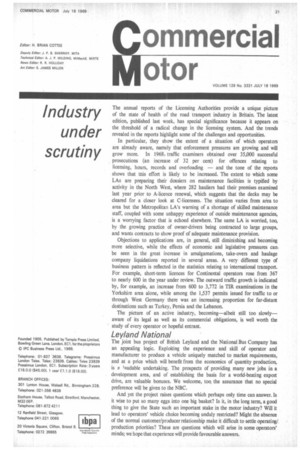Industry under scrutiny
Page 23

If you've noticed an error in this article please click here to report it so we can fix it.
The annual reports of the Licensing Authorities provide a unique picture of the state of health of the road transport industry in Britain. The latest edition, published last week, has special significance because it appears on the threshold of a radical change in the licensing system. And the trends revealed in the reports highlight some of the challenges and opportunities.
In particular, they show the extent of a situation of which operators are already aware, namely that enforcement pressures are growing and will grow more. In 1968, traffic examiners obtained over 35,000 successful prosecutions (an increase of 32 per cent) for offences relating to licensing, hours, records and overloading — and the tone of the reports shows that tnis effort is likely to be increased. The extent to which some LAs are preparing their dossiers on maintenance facilities is typified by activity in the North West, where 282 hauliers had their premises examined last year prior to A-licence renewal, which suggests that the decks may be cleared for a closer look at C-licensees. The situation varies from area to area but the Metropolitan LA's warning of a shortage of skilled maintenance staff, coupled with some unhappy experience of outside maintenance agencies, is a worrying factor that is echoed elsewhere. The same LA is worried, too, by the growing practice of owner-drivers being contracted to large groups, and wants contracts to show proof of adequate maintenance provision.
Objections to applications are, in general, still diminishing and becoming more selective, while the effects of economic and legislative pressures can be seen in the great increase in amalgamations, take-overs and haulage company liquidations reported in several areas. A very different type of business pattern is reflected in the statistics relating to international transport. For example, short-term licences for Continental operators rose from 367 to nearly 600 in the year under review. The outward traffic growth is indicated by, for example, an increase from 600 to 3,772 in TIR examinations in the Yorkshire area alone, while among the 1,537 permits issued for traffic to or through West Germany there was an increasing proportion for far-distant destinations such as Turkey, Persia and the Lebanon.
The picture of an active industry, becoming—albeit still too slowly— aware of its legal as well as its commercial obligations, is well worth the study of every operator or hopeful entrant.
Leyland National
The joint bus project of British Leyland and the National Bus Company has an appealing logic. Exploiting the experience and skill of operator and manufacturer to produce a vehicle uniquely matched to market requirements, and at a price which will benefit from the economics of quantity production, is a laudable undertaking. The prospects of providing many new jobs in a development area, and of establishing the basis for a world-beating export drive, are valuable bonuses. We welcome, too, the assurance that no special preference will be given to the NBC.
And yet the project raises questions which perhaps only time can answer. Is it wise to put so many eggs into one big basket? Is it, in the long term, a good thing to give the State such an important stake in the motor industry? Will it lead to operators" vehicle choice becoming unduly restricted? Might the absence of the normal customer/producer relationship make it difficult to settle operating/ production priorities? These are questions which will arise in some operators' minds; we hope that experience will provide favourable answers.
















































































































